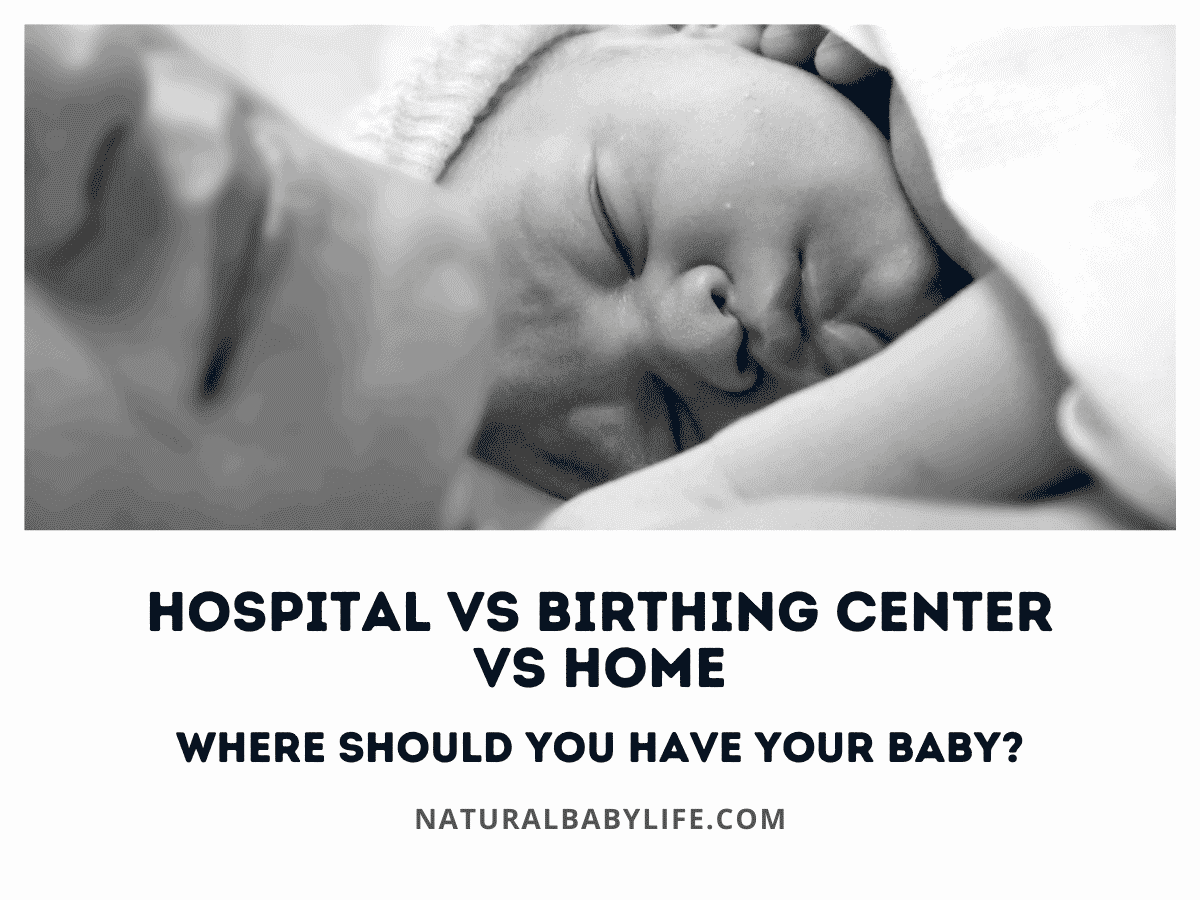Many people do not realize there are legitimate alternatives to hospital births. Birth centers, home births, and hospitals all offer their own pros and cons.
While hospitals offer the maximum level of care and treatment (especially in case of emergency), some mothers and babies do just as well in settings with less medical intervention such as a birthing center or their own home. The “best” place to give birth is very subjective based on each family’s health, support, medical, and even financial needs.
Read on to learn the options offered by hospitals, birth centers, and midwives for home births.
Table of Contents
Should you have your baby at the hospital, a birthing center, or home?
While the vast majority of births in the United States happen in hospitals, other options do exist, namely birth centers and births at home.
These alternatives are not a good fit for everyone. They are very viable options for people with healthy pregnancies and fetuses who feel more comfortable in an out-of-hospital setting.
Birth centers can feel like the perfect in-between because giving birth someplace other than our homes is the norm in modern America. You will receive the same level of care as home birth, but the facilities at the birth center may be more convenient or comfortable, depending on the center and your home. Birth centers may also have ultrasound equipment to perform a high level of prenatal care.
Home births provide comfort and safety to families who do not feel protected in hospitals, whether due to past trauma or institutionalized racism. When attended by an experienced midwife, home births for low-risk mothers have good outcomes for both mother and baby.
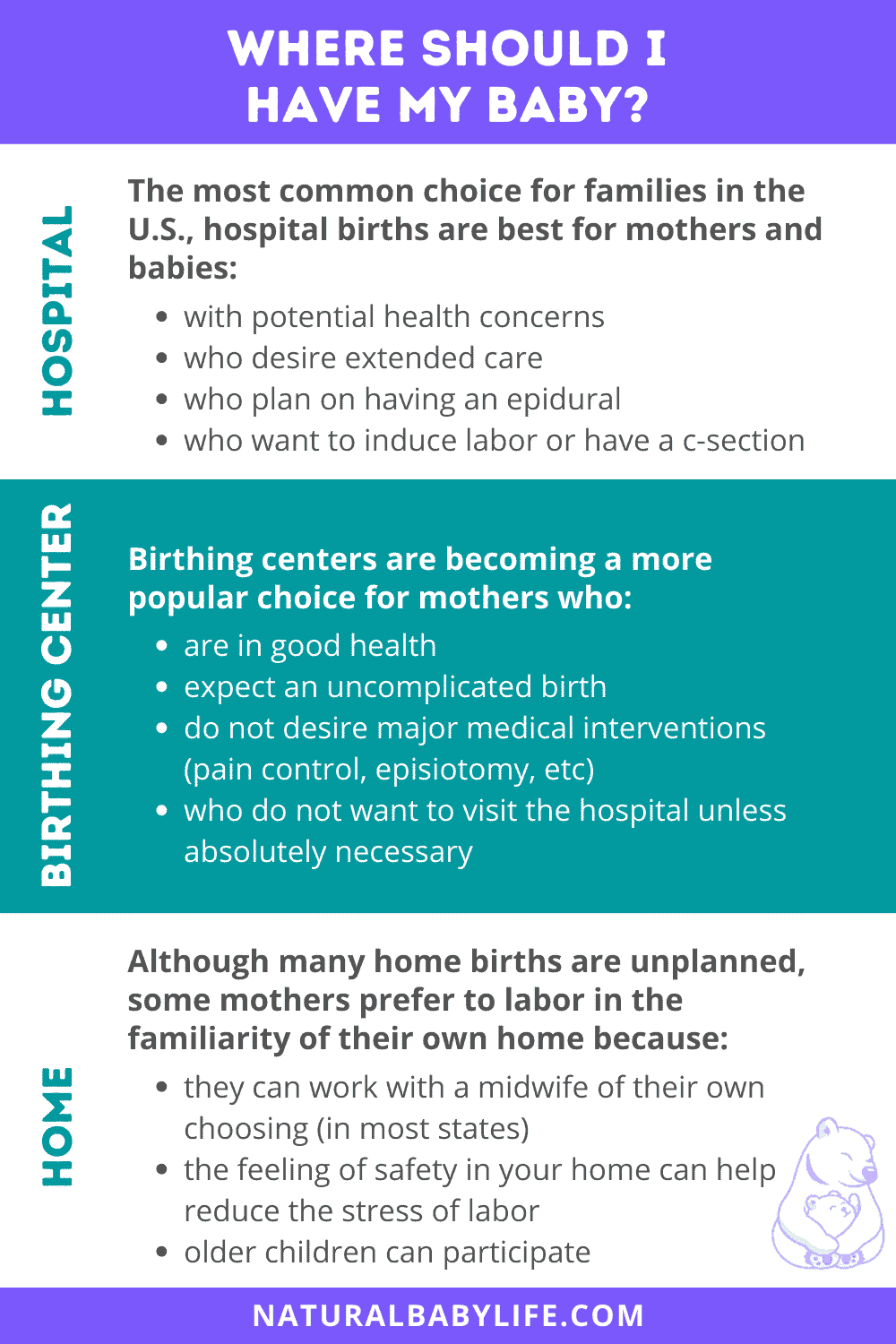
Giving birth at the hospital
Giving birth in a hospital is by far the most common hospital in the United States. So popular in fact that 98.4 percent of births in the United States occur in a hospital. The average out-of-pocket cost for hospital births with insurance is $4,500. This can be more or less depending on each family’s insurance plan and the level of care needed.
Hospitals differ from home births or birth center births in that women enter the hospital fairly early in labor and can proceed with or without pain medication. They will see a multitude of care providers during their stay.
- Nurses check in throughout labor to monitor progress and check in on your needs. They will also provide assistance in the pushing stage. You may see multiple nurses through shift changes.
- Doctors deliver the baby and troubleshoot as needed if complications arise. The doctor who delivers your baby may be whoever is on call and not necessarily the same doctor you saw during prenatal visits.
- Neonatal nurses provide care to the baby directly after birth.
When you labor in the hospital, there may be in-room bathtubs, birth balls, birth stools, and other tools available for natural pain mitigation. Most hospital births occur in the lithotomy position.
You can expect the highest level of monitoring at the hospital. You will likely have an IV inserted upon arrival, will have a heart rate monitor for the baby, and may have your blood pressure monitored throughout.
After delivery, most mothers and babies stay in the hospital for 48 hours after birth as this length is covered by insurance. During that time, mothers can get education regarding breastfeeding and basic baby care. Doctors and nurses will check on both patients throughout the stay.
Advantages of giving birth in a hospital
Hospital births are the default way to give birth in the United States, but that certainly does not mean that it lacks genuine benefits:
- Best care for complicated pregnancies and deliveries. The monitoring and surgical abilities of hospitals can provide the highest and best level of care for pregnancies with complications or babies with health concerns.
- Most comprehensive prenatal care. Doctors also offer the most closely monitored prenatal care. This is great for identifying, monitoring, and treating any concerns with the fetus.
- You get to stay for 48 hours. For some women, having 48 hours in the hospital after delivery is a huge plus. It gives them time to recover without caring for other children or returning to household chores.
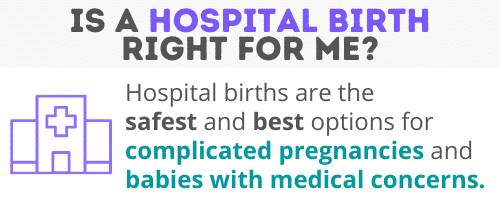
Disadvantages of giving birth in a hospital
Hospitals are not the right choice for everyone.
There are some real disadvantages, and for some people, they are heavily weighted enough to make families consider home and birth center births:
- Poor treatment. Obstetrical violence remains a real problem in the United States, as does institutional discrimination against mothers of color. Lived experience teaches many women that they and their babies are safer in birth centers and at home.
- Desire to demedicalize birth. Many wish to get away from hospital policies and procedures that conflict with the science of birth. Hospitals may lack flexibility in meeting these needs.
- Expense. Depending on your insurance plan, hospital births may be the most expensive. They are certainly the most challenging to budget for given the opaque billing practices and even prices for various treatments.
Should you give birth in a hospital?
Hospitals are the right place to give birth if a full medical team makes you feel safer than a home-like environment.
Hospital births are the safest and best options for complicated pregnancies and babies with medical concerns.
They have the ability to perform surgery and take life-saving measures for both the mother and baby.
Having a baby at a birthing center
Birth centers are standalone medical centers staffed by nurses and midwives with specialized knowledge in prenatal care and delivering babies. If your pregnancy remains uncomplicated, a birth center can provide your prenatal care in addition to attending the birth. About 0.52 percent of births in the United States happen in freestanding birth centers.
Birth centers support unmedicated births and will have many tools and knowledgeable providers to support you during birth. You can expect large, comfortable beds, bathtubs, birthing swings, stools, balls, and more in the private rooms.
The facilities usually have fewer units, and therefore cannot accommodate many birthing mothers at once. It is best to decide on a birth center early in your pregnancy so that you can lock in your due date to essentially make a reservation. Birth centers will limit how many patients with a due date in a specific month that they take on to ensure space for all of their patients.
Hospital vs birthing center
Less than 1 percent of mothers are transferred to the hospital for emergency reasons. Ninety-four percent of mothers attempting birth center deliveries achieve vaginal delivery. Most hospital transfers occur so that the mother can get an epidural or other pain relief during very long labors.
Advantages of giving birth in a birthing center
- More comfortable surroundings. Birth centers provide a home-like environment. They usually have queen-size beds and bathtubs.
- Personalized care. Birth center staff will consist of a handful of nurses, midwives, and support staff. You will be familiar with everyone who may be attending your birth well before the big day.
- Fewer interventions. Birth centers promote natural birth methods like water births and natural pain management through positioning.
- No automatic IVs. Birth centers rarely require the placement of an IV upon admittance for birth.
- Go home more quickly. Assuming all is well with mother and baby, birth centers encourage the new family to rest at home as soon as possible rather than staying multiple days at the center. It is common to be released a few hours after birth.
- Your birth plan won’t be unusual. Birth centers are well-equipped to support unmedicated births.
- Less expensive. Birth center births are about half the cost of uncomplicated hospital birth. Some insurance plans cover birth center births, but you should check with yours before making a final decision.
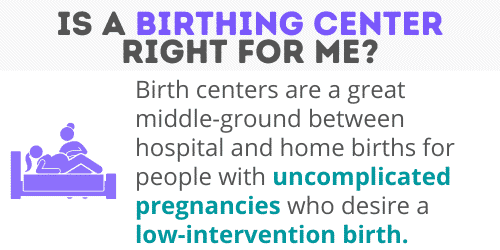
Disadvantages of giving birth in a birthing center
- Not all births qualify. Birth centers face state restrictions regarding the types of births they can have at their facility. Mothers with some pregnancy complications will not be able to use the birth center. Unfortunately, this means some women will need to transfer care in the final weeks of pregnancy, which can be stressful.
- Emergency transfers. Complications with the mother or baby can lead to transfer to the hospital during or after birth. While the medical outcome is predominantly good, this is certainly a stressor and certainly a challenge if only the mother or the baby needs to be admitted.
- Lack of epidurals. Epidurals are exclusively available in hospitals. While you may plan on going through labor naturally, many women change their mind when the time comes.
- Lack of surgery and emergency options. Should an emergency arise, the patient will need to be transported to the hospital.
Should you have a baby in a birthing center?
While the services you receive at a birth center are likely the same you would receive with home birth, birth centers often have transfer plans set up with a close-by hospital.
This ability to have a smooth emergency transfer seems to be a big selling point for many mothers. Birth centers are a great middle-ground between hospital and home births for people with uncomplicated pregnancies.
If the hospital doesn’t feel like the right fit, but a home birth seems too scary, then a birth center is the Goldilocks solution.
Giving birth at home
When you decide to give birth at home, your first step will be to find a home-birth midwife. Keep in mind that while homebirth is legal in every state, there are seven states in which it is illegal for midwives or any other medical professional to assist.
The midwife may perform your prenatal care in addition to delivering your baby. She may also have an assistant to help during the birth. The midwife provides instruction regarding the supplies, like an inflatable birthing tub, that you may want to buy prior to labor.
When labor begins, you will notify your midwife according to the criteria she gives you. When your labor sufficiently progresses, she and her assistant will come to your home. You will be able to give birth in the position of your choosing, and you will be able to have any amount of friends and family present. You can control the lighting, music, and who handles the baby.
Midwives do have medical supplies, including suturing supplies, injectables to stop hemorrhaging, and oxygen.
After you and the baby are settled, the midwife will clean up any mess and likely start a load of laundry. She will also check in on you both during the days following the birth to ensure you are both well.
Hospital vs home birth
The home birth and hospital birth experiences are wildly different.
Hospital births offer the maximum amount of pain treatment, possible interventions, and life-saving measures. However, low-risk and uncomplicated births do not need all of those things.
The challenge and uncertainty surrounding home births is that a low-risk birth could unexpectedly take a wrong turn and become an emergency.
Homebirth statistics 2022/2023
Less than 1% of births occur at home in the United States. Further statistics regarding the outcome of these births can be a bit convoluted due to about 25 percent of home births being unplanned or unattended. Planned home births have monumentally better outcomes.
It is impossible to get truly scientific data from randomized studies regarding home birth outcomes because such a small number of women are interested in home births. Quite simply, people either want one or they don’t, and few women would submit to a random assignment to one or the other.
Much of the safety of a home birth hinges on the selection of a qualified and experienced midwife and the honest analysis of the risks by the mother and medical professional.
Studies of low-risk women beginning labor with the intent to do a home birth versus those intending to do a hospital birth results in similar or better outcomes of the mother, including the same or less hemorrhaging, fewer c-sections, less severe tears, and less infection.
About 1 percent of babies born during planned home births are transferred to the hospital, and some transfers occur for non-emergent reasons. The same study indicates babies born to low-risk mothers have no higher rate of death than babies born to low-risk mothers.
Advantages of a home birth
One vital fact is often overlooked in the discussion around home birth: not everyone feels safe in a hospital or birth center.
Whether through institutional discrimination or individual bad experiences, many women are left with intense anxiety surrounding medical settings. For them, a home birth gives them the opportunity to welcome their child in a comfortable environment where they feel most safe.
There are even more advantages to home births though:
- Accommodates older children. During a home birth, the entire family can remain in one place. Likely, some form of child care will still be needed, but some parents want their older children nearby.
- Feeling safe contributes to a good birth experience. Stress and feeling unsafe can slow labor and make an unmedicated birth more challenging. Some people feel most comfortable and safe birthing at home.
- Less expensive. Having a home birth will likely be less expensive than hospital birth.
- Prenatal care at home. The midwife who will attend the birth may provide prenatal care home calls. This can be a great benefit and convenience to have those visits in your home.
- Relationship with a midwife. You will likely be dealing with the same midwife for all of your prenatal care and your delivery. If you need camaraderie with your birth attendant to feel most comfortable, this method can
- Midwife takes care of the cleanup. One of the biggest misconceptions about a home birth is that you’ll be left with a horrible mess. Check with your midwife, but this is usually something she and/or her assistant take care of. They may also make a meal before they leave.
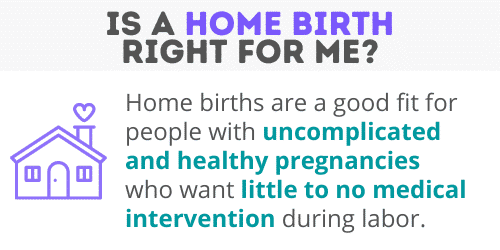
Disadvantages of a home birth
- Not suitable for all homes. Not everyone has a big enough home to accommodate a birth pool or thick enough walls to feel comfortable with what the neighbors may hear.
- Not recommended for complicated pregnancies. Midwives are prohibited by state laws from overseeing some types of births.
- Not allowed in all states. In some states, those who provide home birth services can face legal penalties.
- May require hospital transfer. In the event things do not go as hoped, the mother or baby may need to be transferred to the closest hospital. Depending on the location of the home, this may take too long in an emergency.
- May not be covered by insurance. Your delivery may not be covered in any part. For some people, this is still less than a hospital delivery on a high-deductible plan.
Should you have a home birth?
Home births are a good fit for people with uncomplicated and healthy pregnancies.
They are not recommended for breech births, multiple births, or for vaginal births after a c-section.
People who choose home births want the comfort of their own surroundings and do not find security in a medicalized environment like a hospital. Home births provide the most level of control over the birth experience.

